Essential Waterproof Cameras for Surfing Adventures
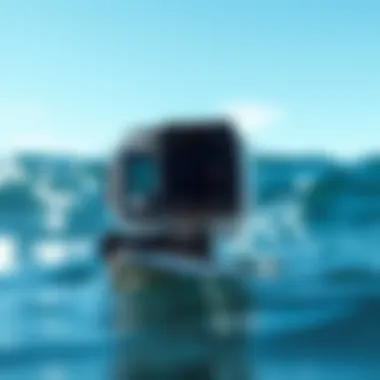
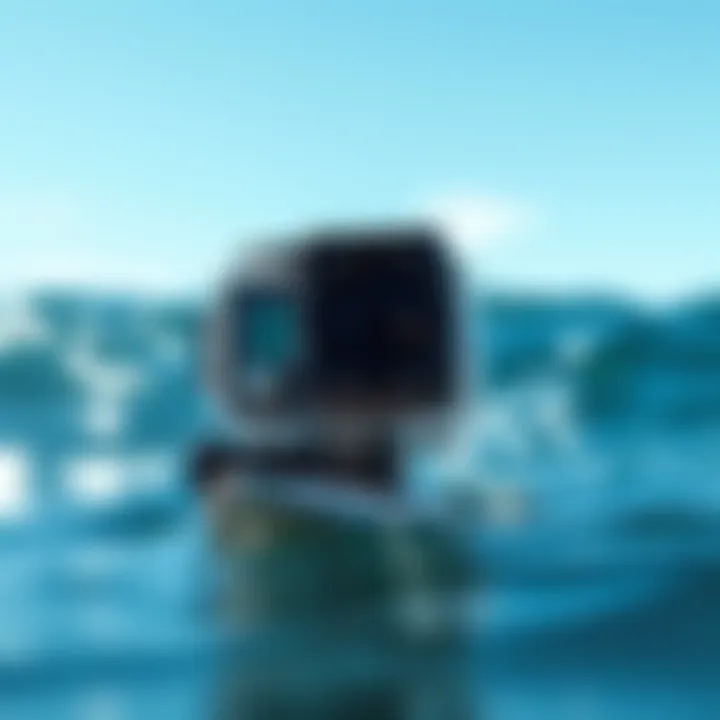
Intro
As more surfers look to capture their high-octane adventures, understanding the dynamics of waterproof cameras becomes essential. The ocean splashes an air of unpredictability, and the last thing a surfer wants is to miss the perfect shot or, worse, damage their gear. This guide will wade through the intricacies of selecting the right waterproof camera, particularly designed for surf enthusiasts.
Choosing a camera isn’t just about pixel count or zoom capabilities; it’s about durability, usability, and functionality in a wet environment. Surfers need to consider several factors, like water resistance ratings, lens quality, and camera operation under various conditions. Whether you’re an amateur eager to preserve your wave-riding memories or a seasoned sailor looking to document your artistic flair, there’s a perfect camera waiting to be discovered.
The subsequent sections will delve into expert insights, equipment recommendations, and tips for maintaining your gear in saltwater conditions. You will learn about the various trends shaping water sports photography, as well as essential safety protocols to follow while shooting amidst the waves. Let’s get started.
Understanding Waterproof Cameras
Waterproof cameras have carved out a niche for themselves in the world of photography, particularly among surfing enthusiasts. The essence of a waterproof camera lies in its ability to withstand harsh aquatic conditions, enabling users to capture their surfing exploits without fret about getting their gear wet. Knowing the details about waterproof cameras can prove invaluable—not just for professional photographers, but also for amateur surfers wanting to document their rides.
Definition and Purpose
The primary definition of a waterproof camera is straightforward: it is designed to be submerged into water without sustaining damage. These devices are purpose-built for those wanting to document their underwater adventures or capture exhilarating moments on the waves. They serve not only to preserve memories but also as helpful tools for professional analysis of surfing techniques and environmental conditions. Understanding this purpose allows surfers to select models that best suit their specific needs, whether it’s high-resolution photos of their best wave or video recordings of intense surfing sessions.
Types of Waterproof Cameras
Across the market, various types of waterproof cameras cater to different strands of need in photography.
Compact Cameras
Compact cameras offer a blend of convenience and capability. They are lightweight, easy to carry, and typically fit snugly in a pocket or a small bag. For surfers, this is advantageous when combined with protective features that allow them to capture shots on the go. The key characteristic of compact cameras is their all-in-one design; you get a camera and waterproof functionality without the hassle of additional housing. However, while their ease of use is commendable, image quality can sometimes fall short compared to other models in challenging lighting situations.
Action Cameras
Action cameras, like the renowned GoPro models, dominate the market when it comes to capturing high-action moments. These cameras are built to take a beating; they are compact, lightweight, and many come with a variety of mounting options. Their most significant allure for surfers is their video capability, often giving stunningly smooth footage amidst the chaos of the waves. A unique feature of action cameras is their versatility; most are equipped with a fisheye lens, allowing for a wider field of view. Nevertheless, while they are excellent for dynamically capturing movement, their still photography capabilities may not always match up to that of specialized cameras.
DSLRs with Waterproof Housing
For those who desire the best in still photography while also wanting to document their time in the sea, DSLRs with waterproof housing provide a compelling option. These setups combine the sophisticated imaging capabilities of DSLR cameras with protective casings that make them suitable for underwater use. The primary advantage here is the superior image quality and flexibility offered by interchangeable lenses, which many compact and action cameras can't provide. However, users need to handle them with care, as setting up a DSLR for aquatic use can be cumbersome and not as portable as other options.
Key Technologies in Waterproof Cameras
Different technologies empower these devices to perform well under wet conditions and before the waves.
Water Resistance Ratings
Water resistance ratings, often measured in meters or IP ratings, play a crucial role in understanding how deep and for how long a camera can be submerged. A common rating like IP68 suggests a high level of protection against water and dust, which is essential for surfers. However, users should know that higher ratings may come with increased costs, something to consider when weighing options.
Lens Construction
The lens of a waterproof camera is another vital aspect; it must resist water, scratches, and impact while maintaining optimal optical quality. The key characteristic lies in its sealed design, preventing water from entering. In practical terms, this means your underwater shots will be clearer, with sharper images than those taken with poorly constructed lenses.
Image Stabilization
Lastly, image stabilization technology is crucial for capturing stable photos and videos amidst the turbulent waters. This feature reduces blur caused by shaking or movement, which is particularly useful when surfing. While not all waterproof cameras come equipped with this technology, those that do often promise clearer and more satisfying results, especially for action shots during rides.
"Understanding waterproof camera technology is the first step towards making informed decisions, particularly for capturing those perfect surfing moments."
In summary, grasping the fundamentals of waterproof cameras can bolster the photography experience for surfers, ensuring capture of those thrilling adventures amidst the waves.
Why Surfers Need Waterproof Cameras
Waterproof cameras have become an essential tool for surfers who seek to document the thrill of riding waves. Capturing the essence of each surf session goes beyond personal nostalgia; it enhances the overall experience in a way that can inspire others. Diving deep into how and why these cameras are valuable, we'll cover three primary aspects: capturing action shots, documenting conditions, and sharing experiences.
Capturing Action Shots
One of the main reasons surfers invest in waterproof cameras is to capture action shots. Wave after wave, the thrill of carving through water and the adrenaline rush that accompanies it is something many wish to immortalize. With a waterproof camera, surfers can snap breathtaking photos while in the midst of the action, whether they are catching a wave or performing tricks.
The beauty of today’s technology allows for impressive image quality, even in splashing conditions. Imagine celebrating a perfect ride with a stunning shot of your amigo catching air above the crest of a wave. Those action shots can not only serve as personal reminders of exhilarating moments but can also bolster a surfer's profile on social media or portfolios.
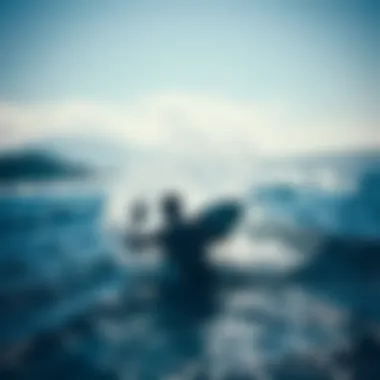

- Consider lenses designed for movement that minimize distortion.
- Use burst mode for multiple consecutive shots to increase chances of capturing the perfect moment.
- Pay attention to settings such as exposure and shutter speed, adapting them for dynamic lighting conditions often found at seaside locales.
Documenting Conditions
Apart from action shots, a waterproof camera offers surfers a unique opportunity to document conditions. Waves can change in a heartbeat due to tides, wind, and weather. These cameras allow surfers to record high-quality images and videos of their favorite surf spots, tracking how conditions evolve over time. Surfing enthusiasts can take notes on their surroundings, including water clarity, wave height, and shoreline changes.
By documenting these elements, surfers can fine-tune their future sessions, picking the right spots based on documented experiences. For some, collecting such footage can also lead to unexpected discoveries of hidden gems, perhaps that wave hardly anyone knows about. Furthermore, this practice helps foster a deeper connection with the environment, increasing awareness of how it can impact surfing dynamics.
"A well-documented journey amplifies the experience, turning moments into memories that last a lifetime."
Sharing Experiences
In an era driven by social media, sharing one’s surfing experiences has never been easier, and waterproof cameras play a crucial role in this aspect. Whether it’s sharing a breathtaking slow-motion video of riding a large swell or a series of snapshots highlighting a surf trip adventure, these cameras give surfers a way to connect with a larger community.
Photographs and videos allow for storytelling; they enable surfers to convey emotions, challenges, and the beauty of their sport. These visuals foster connections with other enthusiasts, inspiring friendships and collaborations across regions. Engaging with others who are just as passionate can lead to new opportunities — perhaps receiving invites for surf trips or gatherings. Many surfers find joy in sharing their journeys, not just to showcase their talents but to encourage newcomers to embrace the waves. Making a point to teach others about the gear and techniques involved in capturing great shots only strengthens the community.
Choosing the Right Waterproof Camera
Selecting the right waterproof camera is pivotal for surfers who want to capture their adventures beyond just riding the waves. The ocean is full of surprises, and a reliable camera can help preserve those moments. Choosing the ideal camera isn't just about picking the most expensive option; it’s about aligning the camera's features with your specific needs. Different surfers have different expectations, from casual beachgoers to professionals looking for that perfect shot. Let's dig deeper into what you should consider when making this important decision.
Determining Your Needs
Skill Level Considerations
When we chat about skill level, it’s not one size fits all. Beginner surfers often prioritize ease of use over complex features, finding themselves more comfortable with cameras that offer straightforward functionalities. On the flip side, advanced surfers may seek equipment capable of capturing intricate details, like high frame rates or specific lighting scenarios. A beginner might find enjoyment in a compact camera that doesn’t overwhelm, while experts may go for DSLRs housed in waterproof cases that allow them to push their limits. Picking the right camera based on your skill will not only enhance your photography but might even boost your confidence on the waves.
Budget Constraints
Let’s face it, the wallet often dictates our decisions. Surfing equipment can drain the funds quicker than a wave can splash. Budget constraints are a major factor in deciding what kind of waterproof camera you can afford. Fortunately, there are plenty of quality options across various price points that don’t skimp on features. A lower-budget camera might not have all the bells and whistles, yet it could still deliver excellent image quality for a casual surfer. Evaluating what you can spend upfront will help streamline your selection process and potentially save you from buyer's remorse. Choosing wisely ensures you can still catch those epic moments without breaking the bank.
Essential Features to Look For
Image Quality
When it comes to image quality, this is a game changer for any surfing adventure. The clarity and color accuracy of photos can make or break your experience. A camera with good image quality captures the essence of a wave much more effectively, turning regular shots into stunning visuals. Surfers benefit from vibrant colors that depict the ocean's beauty and the thrill of the ride. However, don’t get too caught up in megapixels alone; the sensor type and lens quality are equally essential. A camera that balances these factors will likely provide more satisfying results during your sessions.
Video Capabilities
In addition to still images, considering video capabilities is crucial. Surfers often want to share their stunts in motion, and high-resolution video can effectively convey the excitement of riding waves. The ability to shoot in 4K or even 1080p at high frame rates can enhance the visuals dramatically. Additionally, options for slow-motion playback can add a unique perspective that’ll impress your friends. However, the camera you choose should also allow for quick access to these features—nobody wants to miss a great wave fumbling with settings!
Battery Life
Let’s not underestimate battery life; it can be downright frustrating when the camera dies just as the best wave arrives. A longer battery life means more opportunities to record and shoot without fretting over changing batteries. Many waterproof cameras boast decent battery performance, yet differentiating those that offer efficient energy use can save you hassle. Advanced features may consume more power, so a balance between functionality and longevity must be found. Look for models that allow for external battery packs or extended battery options, ensuring you won't miss that shot of a lifetime.
Portability and Mounting Options
Weight and Size
When you're out in the ocean, every ounce matters. The weight and size of your camera can significantly influence your experience. A heavier camera could weigh you down, making it difficult to maneuver on the waves. Compact models often provide the best balance of portability and performance. They fit snugly in your surf bag and can be easily accessed when the shot presents itself. Ensure to consider how portable a camera is so you can focus on riding its a wave, not lugging gear.
Attachment Mechanisms
Just having a waterproof camera doesn’t cut it; how you attach it can be just as important. Various mounting mechanisms allow for easy attachment to your surfboard, helmet, or even pole mounts for that perfect angle. Some cameras come with flexible mounting options that minimize the risk of losing your camera while capturing that sick ride. Not all attachment mechanisms are created equal, so check reviews for durability and ease of use. A secure setup ensures that your gear stays in place, giving you one less thing to worry about when hitting the surf.
Top Recommended Waterproof Cameras for Surfing
Selecting the right waterproof camera is a pivotal step for surfers who want to immortalize their rides and document the surf scene. A quality camera not only withstands water exposure but also captures stunning visuals that reflect the essence of surfing. Understanding the best options on the market can make all the difference between mediocre shots and breathtaking imagery that captures the energy of the ocean. In this section, we delve into industry favorites, new releases, and budget-friendly options, ensuring that all surfers find a camera that suits their needs and budget.
Industry Favorites
When it comes to industry favorites, a handful of models consistently rise to the top for their durability, image quality, and user-friendliness. The GoPro HERO10 Black leads the pack, heralded for its exceptional image stabilization and 5.3K video resolution. Surfers often praise its rugged design and versatility, making it suitable for not just surfing, but various aquatic adventures.

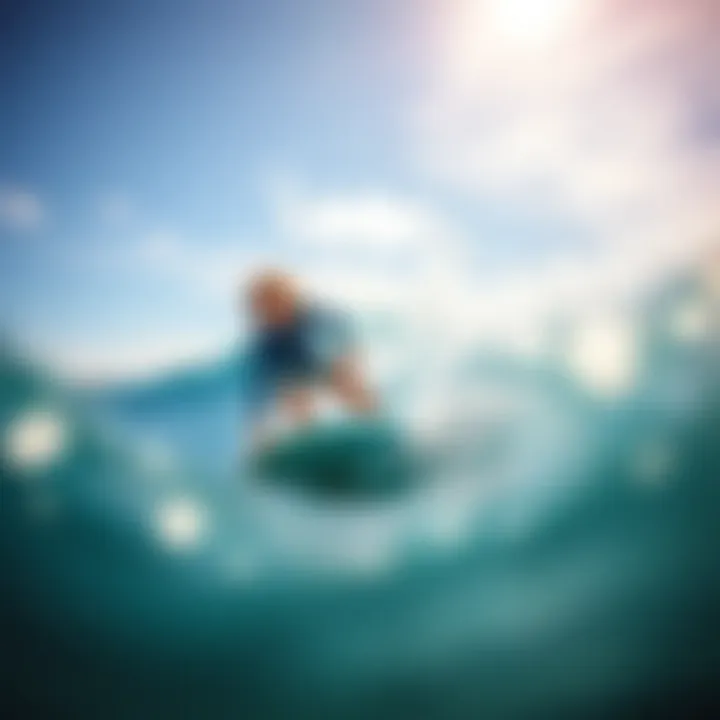
Another strong contender is the Olympus Tough TG-6. Known for its waterproof capability up to 50 feet, this compact camera offers impressive macro modes, making it great for capturing underwater shots. Plus, its rugged build ensures it handles rough surf conditions with ease.
Lastly, the Sony Action Cam FDR-X3000 has gained a loyal following due to its 4K video capability and integrated stabilization. The live-view remote is a nice touch, allowing surfers to frame their shots from afar, an added convenience when catching waves.
New Releases
The realm of waterproof cameras is constantly evolving. New entries bring improved features to the table. The recently launched Insta360 ONE RS combines action and 360-degree photography capabilities in one device. This camera not only captures the horizon but also allows for immersive storytelling – ideal for those looking to showcase their surfing experiences in an innovative manner.
Additionally, the Fujifilm FinePix XP140 received a fresh upgrade that includes enhanced low-light performance and intuitive controls. Its appealing price and decent image quality have made it popular among surfers who don’t want to break the bank.
Budget-Friendly Options
For surfers working with a tighter budget, there are several waterproof cameras available that still pack a punch. The AKASO EK7000 is a highly affordable option, with 4K recording capabilities that don’t skimp on quality. This camera is perfect for beginners who want to explore action photography without financial distress.
Another great choice is the Kodak PIXPRO WPZ2. It’s robust, waterproof up to 10 meters, and offers an easy-to-use interface. With image quality that won’t disappoint, it’s a suitable option for those who are just getting into the surfing photography scene.
"A good thing to remember is, it’s not always about how much you spend; sometimes, it’s about how you use your equipment."
Techniques for Using Cameras While Surfing
Using a camera while surfing is more than just pointing and clicking. It requires a unique set of techniques, especially given the dynamic nature of water and waves. Proper use can allow surfers to capture both breath-taking images and videos that capture the essence of the sport. Understanding the right techniques enhances the quality of the footage, making memories last longer than the ride itself. Here’s a closer look at the vital techniques that can make a world of difference.
Timing Your Shots
Getting the timing right is crucial in action photography. In surfing, waves build and crash at a speed that can be tricky to predict. Taking a shot just a fraction of a second too early or late can mean the difference between a stunning capture and an uninspiring one. Here’s how to nail the timing:
- Watch the Waves: Familiarize yourself with the patterns of the waves. Some may have a consistent break, while others could be more unpredictable.
- Anticipate the Action: Be ready to press the shutter just as the surfer makes that critical move, like a turn or a jump.
- Burst Mode Features: Utilize the burst mode on your camera if available. This feature allows you to capture multiple frames per second, increasing your chances of getting the perfect shot.
Understanding Wave Dynamics
A deep understanding of wave dynamics not only helps capture stunning images but can also keep the photographer safe. Waves can act unpredictably, and knowing what to look for is essential. Consider the following:
- Low vs. High Tide: The conditions of the ocean change between tides. Understand how these variations affect wave height and shape might help in capturing different scenes.
- Type of Waves: Learn the difference between Reef breaks, Beach breaks, and Point breaks, as each forms distinct wave patterns. This knowledge will not only help you capture surfers but also the more dramatic moments of nature.
- Appropriate Positioning: Standing in the right spot can streamline your shots. Positioning yourself closer to the wave can create thrilling images, but be mindful of incoming waves to avoid being caught off guard.
Safety Practices
While focusing on capturing the perfect surfing moment, it's crucial to keep safety as a top priority:
- Wear a Leash: Make sure your camera is securely attached with a strap or leash. This prevents accidental drops into the ocean.
- Avoid Crowded Areas: Staying away from heavy surfing traffic helps prevent accidents. Getting hit by a board or a surfer can be dangerous, especially in turbulent waters.
- Check Weather Conditions: Understand the weather conditions before you even step foot in the water. Stormy weather can change ocean conditions rapidly, making it harder to shoot and risking personal safety.
"If you don’t respect the ocean, it’ll remind you who’s in charge," - adrenaline junkies can surely attest to this.
By mastering these techniques, surfers can not only capture their surfing experiences more effectively, but do so in a manner that is both enjoyable and safe.
Post-Processing Your Surfing Footage
Post-production serves as a vital component in enhancing the quality of your surfing footage. It's the stage where raw clips are transformed into polished pieces ready for sharing or archiving. With the right techniques and tools, you can elevate your visual storytelling, making your surfing adventures not just seen but felt. This enhances not just your personal collection but can also resonate deeply with fellow surfers or enthusiasts.
Editing Techniques
When it comes to editing your surfing footage, employing a few foundational techniques can make all the difference. Below are some techniques you may consider:
- Trimming Clips: Most footage will need some trimming. Cutting down the long waits between waves or removing failed attempts allows your audience to focus on the action.
- Adding Music: Carefully selected background music can significantly influence the vibe of your video. Aim for tracks that complement the energy of surfing, whether it be laid-back acoustic or high-energy rock.
- Color Grading: Adjusting color balance can bring your footage to life. From boosting the colors of the ocean to achieving the right mood, color grading provides depth and intensity.
- Slow Motion Effects: Highlighting specific sections in slow motion can make those epic rides even more dramatic. Use this technique sparingly for maximum impact.
By layering these techniques, you can produce engaging content that captures the essence of the waves.
Software Recommendations
Choosing the right software for post-processing can be just as crucial as the editing techniques you employ. Here’s a short list of some popular tools well-suited for surf footage editing:
- Adobe Premiere Pro: A professional-grade software that accommodates many advanced features. Its flexibility attracts many seasoned editors.
- Final Cut Pro: If you're a Mac user, this software provides a seamless experience with powerful editing capability.
- GoPro Quik: Tailored for GoPro users, this app makes it easy to edit your surfing clips on the go, with user-friendly features that cater to quick edits.
- DaVinci Resolve: A great choice for color correction and professional-grade editing without any cost.
- HitFilm Express: An entry-level option that still offers plenty of robust tools to get beginners started on video editing.
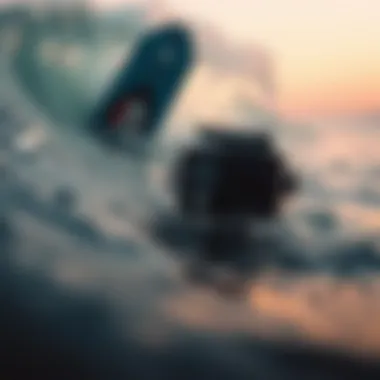
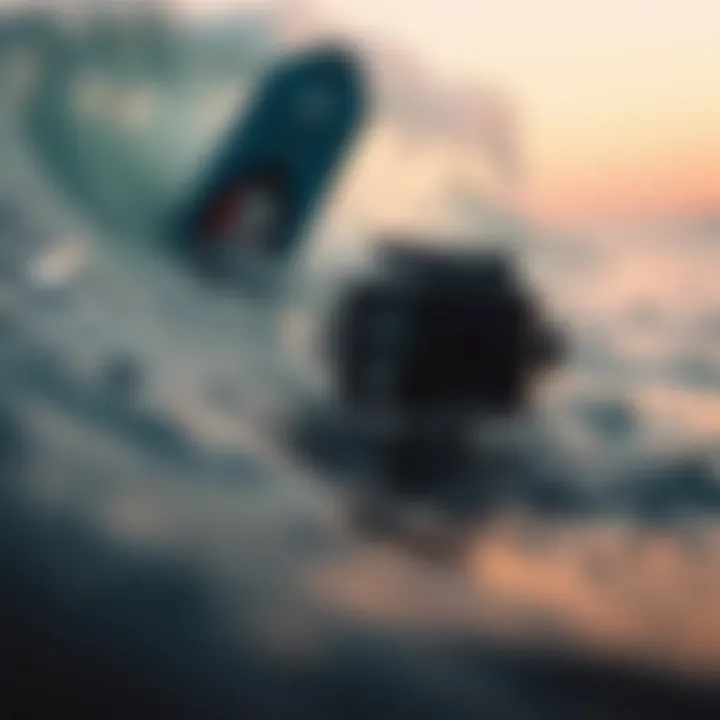
These tools vary greatly in complexity and pricing, making it essential to select one that matches your familiarity and goals.
Sharing Your Work
Once you’ve polished your footage, sharing it effectively is where the excitement really begins. Here are some strategies to make your content resonate:
- Social Media Platforms: Instagram and Facebook allow you to reach a vast audience. Create 30-60 second highlight reels to catch attention quickly.
- YouTube Channels: Upload longer videos on YouTube, utilizing playlists for different locations or trips, enhancing visibility and engagement.
- Surfing Forums and Communities: Engage with dedicated surf communities on platforms like Reddit and Facebook groups. Share your experiences and encourage feedback for new perspectives.
- Personal Website or Blog: If you’re invested in sharing frequently, consider creating a blog. This allows you to provide deeper insights into your surf sessions alongside the footage.
Sharing your work is not just about showing off; it's about connecting with fellow surfers and building a community around shared passions.
Maintenance and Care for Waterproof Cameras
Maintaining and caring for waterproof cameras is paramount for ensuring their longevity and functionality. Surfing often subjects these devices to salty water, sand, and harsh weather conditions. Proper upkeep not only prolongs the life of the camera but directly impacts the quality of the images and videos captured. To make the most of your waterproof camera, let’s break down some essential practices and considerations that every surfer should keep in mind.
Routine Cleaning Practices
After each surf session, it’s crucial to clean your waterproof camera. Even though it’s designed to handle water, salt and sand can create lasting damage if left unchecked. Here are some steps to follow:
- Rinse with Fresh Water: As soon as possible after a session, rinse the camera in fresh water. Be sure the seals and buttons are also flush to keep them free from debris.
- Dry Thoroughly: Use a soft cloth or microfiber towel to dry the camera, paying close attention to crevices where water might linger. Avoid using a heater or hair dryer, as heat can damage electronic components.
- Battery Maintenance: If your camera allows, remove the battery and let it dry separately. Excess moisture can cause corrosion or short-circuits in the battery compartment.
Maintaining a habit of regular cleaning can prevent serious malfunctions down the line and ensure that your camera remains operational.
Storage Considerations
Proper storage is another key aspect of maintaining waterproof cameras. When not in use, how and where you store your camera can make all the difference:
- Store in a Cool, Dry Place: Avoid environments with extreme temperatures or high humidity. A camera bag with silica gel packets can help draw out excess moisture.
- Avoid Direct Sunlight: Prolonged exposure to sunlight can fade the camera’s exterior and harm the internal components. A padded case is best for protecting the device.
- Remove Accessories: If your camera has attachments, like filters or mounts, consider taking them off before storing. These can create pressure points and may lead to unwanted wear and tear.
By being mindful of storage practices, surfers can avoid preventable damage that could shorten the lifespan of their camera.
Troubleshooting Common Issues
Even with utmost care, issues may arise. Here are some common problems faced by waterproof camera users and potential fixes:
- Fogging Lens: If the lens fogs up, it may be due to humidity. Try using anti-fogging products specifically designed for lenses, or store the camera with silica gel to reduce moisture.
- Water Intrusion: If you notice water inside the camera, immediate action is essential. Remove the battery, dry the camera as best as you can, and leave it to air dry completely. If the camera isn't functional after that, professional repairs may be needed.
- Buttons Stuck: Salt and sand can cause buttons to stick. Carefully clean around the buttons using a soft brush or compressed air, but avoid using liquids that could aggravate the situation.
When issues arise, it’s better to act swiftly rather than waiting to see if they resolve themselves. Proper troubleshooting can avert irreversible damage and ultimately save you time and money.
Remember: Regular maintenance and care ensure that your waterproof camera is ready to capture every moment of your surfing adventures without fail!
Closure
The exploration of waterproof cameras for surfers not only sheds light on the vast array of options available but also highlights the essential role these devices play in capturing aquatic adventures. As surfers flock to the waves, they seek to immortalize those exhilarating moments, which is where the right camera steps in. The choices made in selecting a waterproof camera can significantly influence both the quality of the images and the overall experience in the water.
In this piece, we’ve taken a careful look at several critical aspects that should guide your buying decision. From understanding the diverse types of cameras available—compact, action, or DSLRs with waterproof housing—to recognizing the need for certain essential features like image quality, video capabilities, and battery life, every detail counts.
Key considerations include:
- Your skill level: Taking time to choose a camera that matches your experience can prevent unnecessary frustrations in the field.
- Budget: While it’s tempting to go all out for top-tier gear, there are reliable options that don’t break the bank.
- Portability: The compactness and weight of the camera will affect how easily you can manage your gear while paddling out.
By keeping these factors in mind, surfers can better navigate their options and choose a camera that not only meets their needs but also elevates their experience on the waves.
"Choosing a waterproof camera is not just about buying a gadget; it's about enhancing your surf experience and creating lasting memories."
Final Thoughts on Selection and Usage
Finding a waterproof camera that aligns with both your surfing style and your personal preferences is vital. As you venture into this vibrant world, remember to take your time and do thorough research before purchasing. Consider testing a camera in-store, if possible, to ensure it feels comfortable and fits your needs. Don’t shy away from reaching out to fellow surfers or photographers for their recommendations. The experience of others can often provide invaluable insights. Ultimately, a well-chosen camera can transform how you share your surfing stories, allowing creativity to flow as freely as the waves themselves.
The Future of Waterproof Camera Technology
Looking ahead, the realm of waterproof camera technology is poised for exciting innovations. With advancements in sensor technology, we may soon see cameras that offer higher resolutions while maintaining their ability to withstand the elements. The emergence of artificial intelligence within camera software could enhance features like automatic scene detection or real-time editing adjustments, promising a user-friendly experience.
Also, the integration of enhanced connectivity options may allow for quicker uploads to social media or cloud storage, making it easier than ever to share your adventures with friends and followers. As technology progresses, the possibilities seem endless, ensuring that water sports enthusiasts will have even more tools at their disposal to document their experiences.
As surfers continue to embrace the big blue, waterproof camera technology will accompany them, capturing every thrilling moment with clarity and detail that will make looking back at those experiences all the more enjoyable.
For more information about waterproof cameras and advancements in technology, check out Wikipedia and other informative sources like Britannica. Stay sharp and keep snapping those waves!







